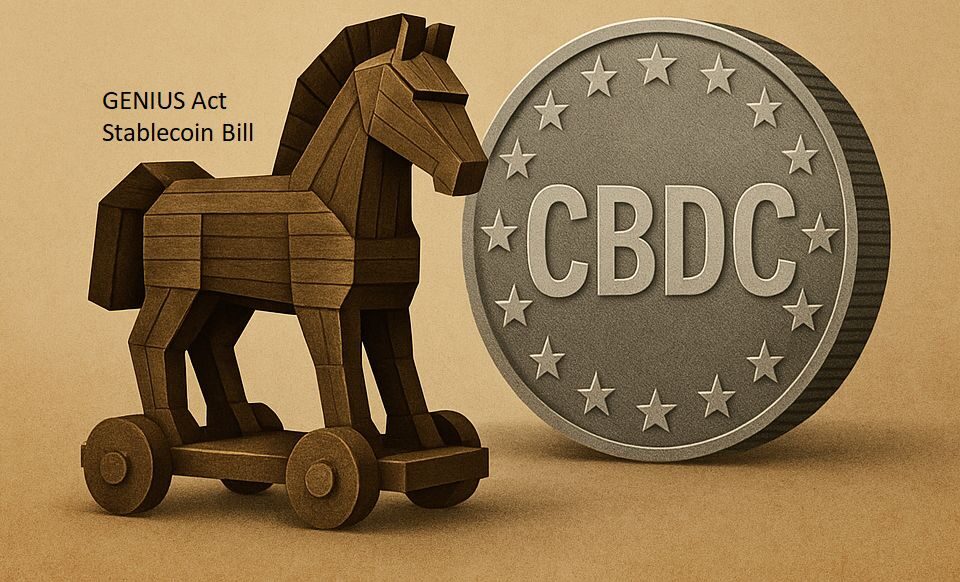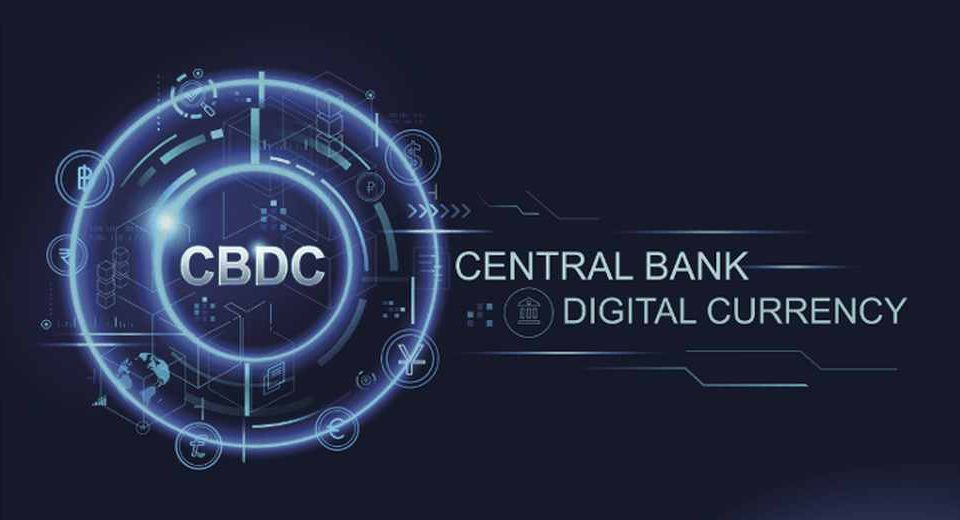The GENIUS Act: A Trojan Horse for a U.S. CBDC Disguised as Stablecoin Regulation?

In June, we wrote about the hidden risks of stablecoins and why they aren’t nearly as “stable” as the name suggests. From redemption risk to reserve opacity and regulatory blind spots, the dangers were already there. But now, the stakes might be even higher.
On July 18, 2025, President Donald Trump signed the GENIUS Act—short for the Guiding and Ensuring National Innovation for U.S. Stablecoins Act. The law drew praise as a major win for crypto innovation in the U.S., setting up the country’s first federal rules for payment stablecoins. These are digital tokens pegged 1:1 to the U.S. dollar, backed by cash or Treasuries. Supporters said it was a step toward stronger consumer protection, dollar dominance, and faster financial innovation.
But beneath all the patriotic language and free-market talk, some people are starting to ask hard questions.
Like—what exactly are we building here?
And is this quietly becoming a phased rollout of programmable digital money?
The GENIUS Act doesn’t create a central bank digital currency (CBDC)—in fact, it says it’s designed to stop one. But in reality, it might be doing something even more powerful: laying down the rails that a future CBDC could glide in on.
This article digs into that possibility, not out of fear, but through pattern recognition, historical memory, and clear-eyed logic. Because when it comes to something as fundamental as money, what begins as a “feature” can quickly morph into a requirement.
What the GENIUS Act Really Does
On the surface, the GENIUS Act is about regulatory clarity for stablecoins. It creates legal pathways for companies to issue digital dollars, as long as they follow strict rules. Here’s a breakdown of what the law actually does:
1. Regulates Fiat-Backed Stablecoins
The Act applies only to “payment stablecoins” that are:
-
Fully backed 1:1 by U.S. dollars or short-term U.S. Treasury assets
-
Issued by licensed nonbanks, banks, or certain qualified fintech firms
-
Designed for everyday use in payments, not speculation
Algorithmic and crypto-collateralized stablecoins? Excluded.
2. Mandates Compliance & Reporting
All issuers must:
-
Submit to monthly audits and disclosures
-
Maintain strict AML and sanctions compliance
-
Provide full transparency into custody arrangements and reserves
In short: if you want to issue digital dollars in the U.S., you’re going to play by Washington’s rules.
3. Ties Private Innovation to Federal Oversight
Though stablecoins remain technically private, the framework puts their infrastructure, custody, and auditing under federal surveillance. It’s a hybrid system—private actors running on government-defined rails.
4. Includes a “Ban” on Retail CBDCs
To pacify critics, the law was paired with the Anti-CBDC Surveillance State Act, which prohibits the Federal Reserve from issuing a retail central bank digital currency directly to consumers.
That clause was intended as a constitutional safeguard.
But—as we’ll explore next—it may be a little more than a temporary speed bump on a much longer road.
The Backdoor to CBDC

On paper, the GENIUS Act looks like a win for innovation. It supports private companies like PayPal and Circle in issuing their own stablecoins, backed by real U.S. dollars and regulated for consumer safety.
But here’s the question:
“Why would the federal government invest so heavily in building the rails for private stablecoins—if it didn’t plan to use those rails itself?”
Let’s break it down.
A Phased Approach to Control
Most major shifts in power don’t happen overnight. They happen through a phased rollout—each step sounding reasonable on its own until you’re locked into a system that can’t be reversed.
Here’s how the GENIUS Act fits that mold:
-
Phase 1: Normalize Digital Dollars via Trusted Brands
“Don’t worry—it’s just PayPal and Circle. Private innovation! Free market! 🇺🇸”
Familiar brands build trust. Consumers adopt stablecoins through apps they already use. -
Phase 2: Standardize the Infrastructure
Compliance becomes mandatory. All stablecoin issuers must follow the same template—monthly reporting, reserve requirements, and government-approved custodians. The “market” becomes a managed market. -
Phase 3: Quiet Consolidation of Control
With most Americans using regulated wallets and stablecoins, all it takes is one crisis—a cyberattack, economic panic, or “misinformation emergency”—for the government to say:“For national security, we’ll take over issuance directly.”
They wouldn’t call it a CBDC. They’d rebrand it as something more palatable:
FedPay. Digital Cash Standard. TrustToken.
Real-World Precedent: The PayPal Speech Fine
Back in 2022, PayPal quietly inserted a clause into its Acceptable Use Policy that allowed it to fine users $2,500 for “misinformation.” The public backlash was immediate. PayPal quickly backtracked, calling it a mistake.
But the message was clear:
If a digital platform can freeze or fine you, it eventually will.
Now imagine a future where your money isn’t just held in a PayPal account, but is itself a federally regulated digital token that lives in a “compliant wallet.”
What happens when the same logic applies, only this time, it’s backed by law?
Insight: Control Doesn’t Require Ownership
The GENIUS Act doesn’t hand the Fed control of your money—not yet. But it doesn’t need to.
By programming the rules, government regulators can dictate how money works—who can send it, where it goes, and what it can or cannot do—without ever issuing a formal “CBDC.”
It’s not what they call it.
It’s what it enables.
The Slippery Slope We Can’t Ignore
Laws rarely stay static, and the GENIUS Act is no exception. While it clearly states that the Federal Reserve is barred from issuing a retail CBDC, that’s only true as of now. Policies evolve. Definitions shift. And what sounds protective today may be reinterpreted or rewritten tomorrow.
That’s why this isn’t just about what the GENIUS Act says.
It’s about what it sets in motion.
Infrastructure Becomes Destiny
Once stablecoins become the default way to store and send money—especially through familiar services like PayPal, Venmo, or Coinbase—the transition to a centralized version doesn’t require legislation. It only takes a backend upgrade.
It could look like this:
-
Your “USD Coin” updates its smart contract with new compliance rules.
-
Wallets now require biometric login for “safety.”
-
New terms pop up: “Funds may be paused or redirected under emergency conditions.”
No one calls it a CBDC.
But it behaves like one.
And because the infrastructure already exists, the shift can happen quietly, through regulation, not legislation. Through software, not a Senate vote.
The Rebranding Playbook
Governments around the world know that public resistance to CBDCs is strong. That’s why any future digital dollar rollout will likely be rebranded to avoid triggering alarm.
You won’t see headlines announcing:
“Federal Government Launches Central Bank Digital Currency”
Instead, you’ll see:
“Fed introduces Trusted Digital Cash Standard to streamline payments and fight fraud.”
Same function. Different label.
Historical Echoes
This isn’t paranoia—it’s precedent.
-
The Patriot Act, passed after 9/11 to protect national security, ultimately enabled warrantless surveillance and mass data collection.
-
Social media platforms that started as “free speech zones” now routinely moderate speech in ways that mirror state priorities.
-
And as we’ve already seen, payment platforms have flirted with freezing funds over ideology.
Why would digital money be any different?
Once a system is in place that lets regulators monitor, restrict, or redirect funds… It’s only a matter of time before it’s used.
What Critics Are Already Saying
It’s not just fringe theorists or anonymous Reddit threads raising concerns about the GENIUS Act. Even some elected officials and seasoned observers are starting to connect the dots—and the reaction has been far from universally positive.
Rep. Marjorie Taylor Greene’s Warning
Shortly after the bill passed, Rep. Marjorie Taylor Greene (R-GA) sounded the alarm on social media, calling the GENIUS Act a “gateway to a government-controlled cashless society.” Her concern?
“I just voted NO on the Rule for the GENIUS Act because it does not include a ban on Central Bank Digital Currency and because Speaker Johnson did not allow us to submit amendments to the GENIUS Act. Americans do not want a government-controlled Central Bank Digital Currency,” she said in a post on X.
Her remarks drew criticism from some establishment voices, but they also resonated with privacy advocates, libertarians, and even ordinary citizens who remember what happened with PayPal or GoFundMe during politically charged events.
Crypto Community Backlash
On forums like Reddit and X (formerly Twitter), the bill is being described as a “CBDC Trojan horse”:
“The GENIUS stablecoin bill, introduced by Senator Bill Hagerty, is criticized as a potential gateway for central bank digital currency (CBDC) control under the guise of privatization. Jean Rausis, co-founder of Smardex, argues that the bill’s stricter regulations on stablecoins mimic EU’s MiCA framework and could centralize control while appearing decentralized.”
Some posts have gone viral, pointing out how monthly audits, KYC, and real-time reserve tracking are all pieces of a broader financial control system—one that’s already far more intrusive than most people realize.
Policy Experts Are Taking Notice
Even some policy experts are raising red flags. In a piece for Forbes, Dave Birnbaum warned:
“Although GENIUS does not explicitly forbid a CBDC, it makes the introduction of one much more difficult in practical terms. The market structure that GENIUS provides to stablecoin issuers will change how dollars flow through the U.S. using private and state-regulated institutions, creating facts on the ground that will make it more difficult for the government to ever force through a CBDC that violates the natural rights of Americans.”
Birnbaum continued:
“Failing to integrate stablecoins with the U.S. banking system makes a CBDC more likely. If this session of congress demonstrates that it will not pass straightforward legislation on its own terms to modernize the dollar, a future session controlled by the opposition, which tends to be more amenable to centralized control, may advance a CBDC as the only viable solution to fixing our badly-outdated banking system.”
The Common Thread?
Whether it’s political figures, crypto enthusiasts, or cautious economists, the concern is the same:
The GENIUS Act builds the rails
The public is getting comfortable with programmable money
A centralized replacement is no longer a leap—it’s a tap away
Why This Matters for Every American
You don’t need to own Bitcoin or follow crypto news to care about what’s happening here. Because this isn’t just about digital assets or stablecoin tech—it’s about freedom, privacy, and control.
And the truth is, most people won’t see the shift until it’s too late.
Privacy Is Already Being Redefined
Under the GENIUS Act, stablecoin issuers must provide monthly reports to federal regulators. That means transaction flows, reserves, custody details—all disclosed regularly to Washington.
Add to that the KYC and AML mandates that already require users to upload IDs, verify addresses, and in some cases, submit biometric data.
We’re entering a financial system where:
Access to money is conditional.
All transactions are traceable.
And your balance can be paused, reversed, or restricted—without court involvement.
That’s not theory. That’s infrastructure.
Programmable Money = Behavioral Control
The danger of digital money isn’t just surveillance—it’s behavioral conditioning.
Programmable stablecoins make it technically trivial to:
-
Freeze the funds of people who say the “wrong” thing
-
Redirect stimulus to “approved” spending categories only
-
Automatically fine users for violating platform policies
You don’t need a CBDC for that.
You just need enough people using a digital token that can be modified remotely.
And with the GENIUS Act, we now have a legal framework for those tokens to become the norm.
Opting Out Will Become Harder
The transition won’t be forced. It’ll be marketed as a convenience:
-
“Faster than ACH”
-
“No wire fees”
-
“Direct-to-wallet tax refunds”
Meanwhile, cash usage will decline. Paper checks will disappear. And traditional bank accounts will quietly become incompatible with the “modern financial stack.”
By the time people realize what they’ve given up, opting out won’t be practical anymore.
Because when the system decides how your money works, you’re no longer the owner. You’re just a user.
Conclusion: What’s Genius for Some, Could Be Dangerous for All
The GENIUS Act has been marketed as a breakthrough for crypto innovation—a patriotic, dollar-backed answer to the chaos of unregulated tokens and foreign digital currencies. And on the surface, it delivers just that: a cleaner path for private companies to issue fully-reserved stablecoins under U.S. law.
But beneath the policy papers and press releases, something more foundational is happening:
We are quietly rebuilding the architecture of money.
Once the public is onboarded to programmable dollars through private wallets, and once those wallets follow federal rules down to the code, it becomes easier—almost inevitable—for those same rails to carry something far more centralized, far more permanent: a U.S. government-issued digital dollar.
The name won’t matter. Whether it’s called a CBDC, FedPay, or Digital Cash Standard, the effect will be the same:
-
Programmable transactions
-
Real-time surveillance
-
Conditional access to your own funds
And the most dangerous part?
Most people will accept it, because it won’t feel like a loss.
It will feel like an upgrade.
We’re not raising alarm—we’re raising awareness.
The GENIUS Act may not be a CBDC. But it might be something even more effective: the Trojan horse that delivers one quietly, legally, and irreversibly.
It’s not about fear.
It’s about foresight.
Because freedom is easiest to lose when it’s quietly redesigned.




